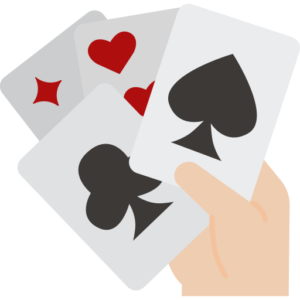Glossary Term
Board Cards
Board Cards
Used In: Poker
Introduction
Bluff cards in poker refer to specific hands that players use to deceive their opponents into thinking they have a stronger hand than they actually do. These hands are typically weak or have little potential to improve, but the player bets or raises aggressively to create the illusion of strength. The goal is to force other players to fold better hands, allowing the bluffer to win the pot without having to show the best cards.
The key to using bluff cards effectively is understanding the situation and the players at the table. A successful bluff relies on factors like the size of the bet, the timing, and how well the player reads the other participants. For example, bluffing on a board that seems favorable for strong hands can make opponents more likely to fold, even if they have a better hand. Bluff cards can be used in a variety of ways, but they work best when the player is able to convincingly tell a story with their betting pattern.
While bluff cards can be a powerful tool, they require careful use. Bluffing too often can make a player predictable, and opponents may catch on to the strategy. Additionally, bluffing with the wrong cards or in the wrong situations can lead to significant losses. Bluff cards are most effective when used sparingly and with clear understanding of the dynamics of the game.
In Depth Look
Bluff cards in poker are hands that have little to no potential for winning but are used to mislead opponents into thinking the player has a stronger hand. The essence of bluffing is to create doubt and uncertainty in the minds of other players. It’s not just about the cards you hold, but about how you project strength through your betting patterns. For example, a player might hold a low pair or a hand with no real chance of improvement, but by betting aggressively, they can convince opponents to fold their better hands. A bluff works best when the board presents opportunities that could support a stronger hand, like a possible straight or flush, even if the bluffer holds no such cards.
However, bluff cards can backfire if not used wisely. Successful bluffing depends on timing, reading the table, and understanding the tendencies of the other players. Overusing bluff cards can make you predictable, and experienced players will catch on to the strategy. The best time to bluff is when the table dynamics suggest that your opponents are likely holding weaker hands or when the community cards have created a situation where only a few hands make sense. Bluffing with weak hands or in situations where your opponents are unlikely to fold can result in significant losses, so it's crucial to assess each situation carefully.
Key Points:
- Bluff cards are weak hands used to mislead opponents.
- Timing and reading the table are crucial for successful bluffing.
- Overusing bluff cards makes a player predictable.
- Bluffing works best when opponents are likely holding weak hands.
- Carefully assess the situation to avoid unnecessary losses.
Mechanics
The mechanics of bluff cards in poker are based on the concept of deceiving opponents through strategic betting. A player uses a weak hand to create the illusion of a strong one, typically by making large bets or raises. The idea is to pressure opponents into folding, even if they have a better hand. To pull off a successful bluff, a player needs to maintain consistency in their betting patterns, matching the behavior of a strong hand. If the player suddenly makes an unexpected bet or raise, it can alert others that they may be bluffing. Therefore, the key to bluffing is to be subtle and believable, maintaining control over the pace of the game without tipping off the other players.
Bluffing also requires the player to consider the texture of the board and the actions of other players. For instance, if the community cards suggest a possible straight or flush, opponents may be more likely to fold weaker hands, believing the bluffer is holding those winning combinations. The position at the table is another critical factor—players in later positions have more information about their opponents’ actions and can use this to craft their bluff more effectively. The size of the bet is important as well; a well-timed, proportional bet will often induce a fold, whereas a bet that’s too large or too small might raise suspicion. Ultimately, bluffing with the right mechanics involves understanding how to manipulate the flow of the game and manage opponents’ perceptions.


Illustrated Example
Imagine you're playing a poker hand, and you hold a 7♠ 2♦—a weak hand that has little chance of winning on its own. The community cards are 8♣ 10♠ J♦, creating a potential straight for anyone holding a 9. In this situation, you decide to bluff, hoping to make your opponents fold. If you're in a late position, and everyone before you has checked, you might raise the pot aggressively, suggesting that you have a strong hand, such as a completed straight or a high pair. By doing so, you create the illusion that you have a winning hand, and if your opponents are cautious or already holding weaker hands, they may fold, leaving you with the pot.
Let’s break this down with a simple table of possible actions during this hand:
| Player | Cards | Community Cards | Action Taken | Result |
|---|---|---|---|---|
| You | 7♠ 2♦ | 8♣ 10♠ J♦ | Raised the pot aggressively | Opponents fold, you win the pot |
| Opponent 1 | 9♣ 8♠ | 8♣ 10♠ J♦ | Checks | Folds to your aggression |
| Opponent 2 | K♠ Q♦ | 8♣ 10♠ J♦ | Calls | Stays in the hand |
| Opponent 3 | 6♠ 5♣ | 8♣ 10♠ J♦ | Folds | Won’t risk the pot without a strong hand |
Player Perspective
From a player's perspective, bluffing with weak hands can be both an exciting and risky strategy. When using bluff cards, the goal is to manipulate the perception of other players, making them believe you have a stronger hand than you actually do. This requires careful attention to their behavior, as well as the overall dynamics of the game. A well-timed bluff can create opportunities to win pots without having the best hand, but it relies on the ability to read the table and understand when opponents are likely to fold. For a player, executing a successful bluff often feels like a mental challenge, requiring both confidence and patience to carry it through.
However, bluffing also has its downsides. A failed bluff can quickly put a player at a disadvantage, especially if their opponents catch on to the strategy. If you bluff too often, experienced players will begin to call your bets more frequently, knowing you're trying to mislead them. It can be tempting to bluff in every situation, but it’s important for players to choose their moments wisely, balancing the risk with the potential reward. In the end, bluffing is about controlling the flow of the game and keeping your opponents uncertain about the strength of your hand. It’s a skill that comes with experience and an understanding of both your own playing style and that of your opponents.
Conclusion
In conclusion, bluffing with weak hands, or bluff cards, is a vital element of poker strategy that requires skill, timing, and awareness of the table dynamics. When done correctly, it can pressure opponents into folding stronger hands and allow you to win pots without having the best cards. However, bluffing is a double-edged sword—while it can be a powerful tool, overusing it or executing it poorly can lead to significant losses. The key to success lies in understanding when to bluff, how to read your opponents, and maintaining a balance between deception and predictability. With practice, bluffing can become an effective way to control the pace of the game and gain an edge over your competitors.
The Top Online Casinos for Playing Poker
These platforms prioritize player satisfaction by providing intuitive interfaces, seamless gameplay experiences, and robust security measures to ensure a fair and enjoyable environment for all users.


Author
Branimir Ivanov | Senior News Contributor








